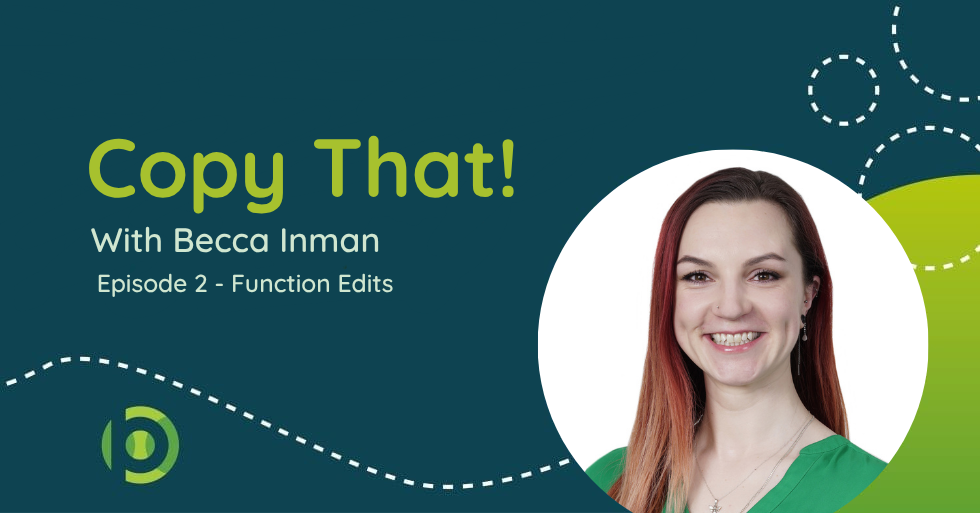Welcome to the second instalment of the how-to-edit-your-copy series.
This month, we’re talking about…
✨Function Edits✨
What Are Function Edits?
Function edits are exactly what they sound like. They make sure every part of your copy functions the way it should, i.e. each paragraph, section, and argument flows logically and supports your ultimate goal. A lot of what you do when it comes to functional edits is actually going through and moving sentences and sections around to make sure the copy has the effect you want.
Think of functional editing as the process of zooming out and looking at the big picture. You’re asking:
- Does this argument build clearly from point to point?
- Is the order of sections helping or hurting the message?
Am I delivering my strongest point at the right moment?
Function edits ensure your copy isn’t just written well, but built well. And when it’s built well, it’s better at grabbing attention, keeping it, and converting it into action.
Why Functional Edits Matter
Bad structure can sabotage even the best ideas. If your most compelling benefit or insight is buried halfway through a confusing structure, the reader might never get there. And if sections don’t build logically, they can confuse or lose people entirely.
On the other hand, when your copy is structured well, the reader flows naturally through your ideas. Every point connects. Every paragraph leads naturally on to the next. And the outcome is higher engagement and a message that actually lands.
Function Editing Tip #1: Follow the Golden Thread
One of the best techniques for function edits is something called the golden thread.
The golden thread is the main idea or theme that weaves through your entire piece and ties it all together. Every section, every example, every claim should reinforce your message. If something wanders off-topic or distracts from that thread, it probably needs to be cut or reworked.
Weak Example (Golden thread breaks):
“We built our platform in 2018 with a remote-first team, inspired by our founder’s passion for automation. Today, we serve clients in over 12 countries.”
“We built our platform in 2018 with a remote-first team, inspired by our founder’s passion for automation. Today, we serve clients in over 12 countries.”
(This adds backstory and trivia, but doesn’t advance the goal of conversion or directly support the core benefit.)
Stronger Example (Golden thread intact):
“Most SaaS teams waste 63% of their ad spend. Our targeting system helped [Client] cut CAC by 42% in 90 days. Want results like that? Let’s talk →”
(This keeps the message laser-focused on the problem and solution.)
(This keeps the message laser-focused on the problem and solution.)
Fix: Cut anything that doesn’t directly support your conversion goal. Keep the thread tight and clear.
Function Editing Tip #2: Use Reverse Outlining
So, you know you need good structure, but what does good structure look like? One way of finding out is to use reverse outlining.
Reverse outlining means taking a look at some best-in-class examples and analysing what each section is doing. Not what it says, what it’s doing. Is it building credibility? Introducing a problem? Offering proof? Once you know the winning formula, then you can use that same framework to shape your own writing.
For example:
Landing Page Breakdown (SaaS)
- Headline: “Automate Your Client Reporting in 5 Minutes” = Specific result + time frame
- Subhead: “How 3,200+ agencies save 10 hours/week” = Credibility indicator + tangible outcome
- Demo Video: “30-second explainer” = Visual proof + Features/Benefits
- CTA: “Start Free Trial→” = Low-commitment next step
Over time, reverse outlining helps you see patterns. You’ll notice that, for example, credible proof often comes before a big product reveal. Or that calls-to-action tend to follow emotional stories. These patterns become templates you can repurpose.
The more you study structure this way, the better your instinct for function edits becomes. You’ll know what works, and why.
Function Editing Tip #3: Try Spit Drafting
One more way to make function edits easier, or even avoid needing them at all, is spit drafting.
Spit drafting is basically a really quick way to plan your copy. Rather than writing full paragraphs or even headings, you just sketch out what you’ll say before figuring out how you’ll say it.
For example, you might jot down:
- Problem
- Agitate that problem
- Introduce solution
- Claim
- Proof
- Add testimonial
Call to action
Or apply it in an email sequence framework:
- Subject: “Your [pain point] solution?”
- Opener: “I noticed you [specific behaviour]…”
- Story: “We helped [similar client] get [result]”
- CTA: “Let’s discuss how we can help →”
The goal is to make sure your copy’s structure is sound before you commit to writing. You’re just outlining the flow for now, and the details can be filled in later.
It’s kind of like storyboarding before you make a film. Once you’re happy with the rough shape, the actual writing becomes much easier and more focused, and you’ll need fewer structural edits later on.
Key Takeaways
If your copy isn’t working the way you want it to, the issue might not be the words themselves but the order they appear in. That’s why functional editing is so important.
Tips for functional editing:
1. The Golden Thread (Keep Messaging Tight)
Every sentence should tie back to your core offer. Cut anything that doesn’t directly support the conversion goal.
2. Reverse Outlining (Structure Optimisation)
Deconstruct high-converting assets to understand their flow and apply it to your writing.
3. Spit Drafting (Strategic Planning)
Outline the conversion path before writing words.
By learning to spot structure issues, following a golden thread, using reverse outlines, and planning your copy with spit drafts, you’ll create writing that flows better, connects faster, and ultimately performs stronger.
So next time you sit down to polish a draft, zoom out. Ask yourself, “Is this copy functioning the way I need it to?”
Because when your message is structured right, everything else gets easier.

